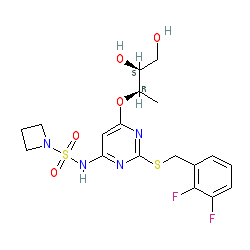|
Synonyms: AZD-5069
Compound class:
Synthetic organic
Comment: AZD5069 is a novel, selective antagonist of the chemokine receptor, CXCR2. The structure shown here was drawn from that in [6], which specifies stereochemistry. This structure is identical to Example 47 in patent US7838675 [1]. PubChem records the structure with no specified stereochemistry (CID 59558839).
Small-molecule antagonists of CXCR2 are being developed for their potential to treat inflammatory conditions. Ligand Activity Visualisation ChartsThese are box plot that provide a unique visualisation, summarising all the activity data for a ligand taken from ChEMBL and GtoPdb across multiple targets and species. Click on a plot to see the median, interquartile range, low and high data points. A value of zero indicates that no data are available. A separate chart is created for each target, and where possible the algorithm tries to merge ChEMBL and GtoPdb targets by matching them on name and UniProt accession, for each available species. However, please note that inconsistency in naming of targets may lead to data for the same target being reported across multiple charts. ✖ |
|
|||||||||||||||||||||||||||||||||||
| Immunopharmacology Comments |
| AZD5069 is an orally-active small molecule antagonist with over 100-fold selectivity for the human CXCR2 relative to CXCR1. Its ability to selectively block neutrophil migration in the blood, bronchial tissues and sputum has been demonstrated in patients with severe asthma [7,10]. This compound has been extensively studied as an anti-inflammatory agent in other chronic respiratory diseases [5], including COPD [4,8] and bronchiectasis [2]. In addition to acting as an effective neutrophil trafficking inhibitor, AZD5069 can also stabilise NET formation in COPD-derived neutrophils [8]. It has been shown that the anti-neutrophil migratory actions of AZD5069 via CXCR2 blockade do not adversely affect neutrophil-mediated host immunity following chronic dosing [3,9]. |








